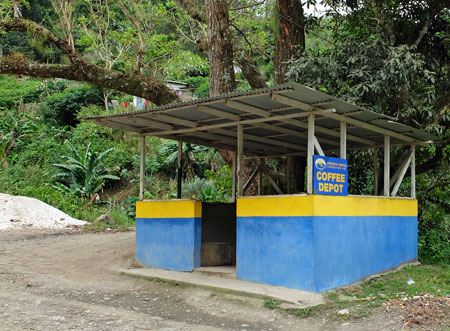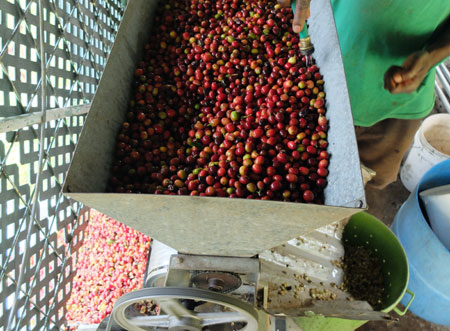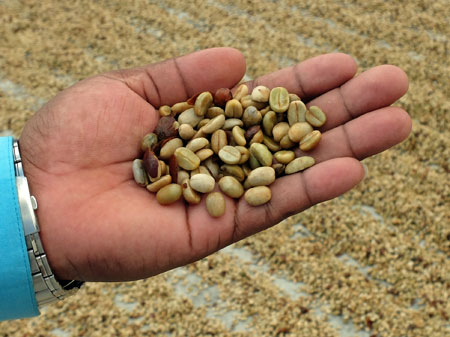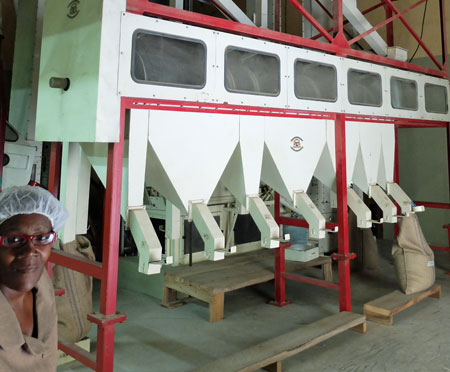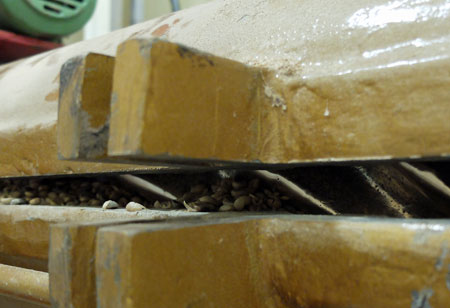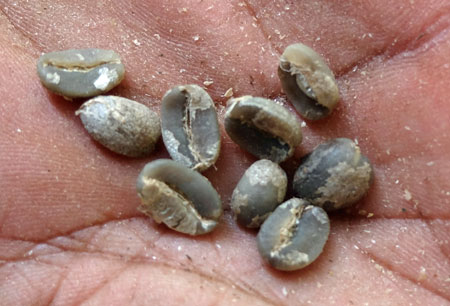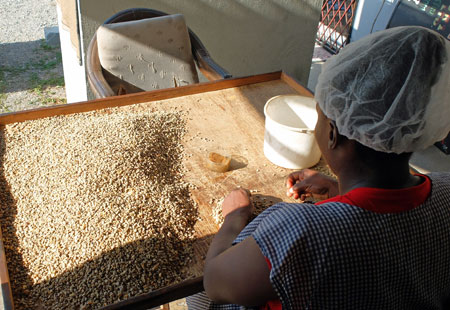Processing coffee in Jamaica’s Blue Mountains.
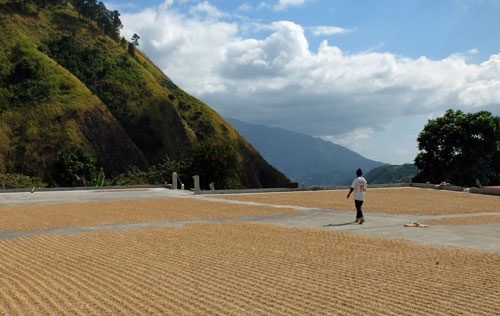 At the "wet parchment" stage, the coffee beans are laid out in the sun to dry. (One of my favorites among the photos I took while in Jamaica.)
At the "wet parchment" stage, the coffee beans are laid out in the sun to dry. (One of my favorites among the photos I took while in Jamaica.)In my previous article I followed coffee in Jamaica from the seedling to harvest. In this piece I’ll pick up from the moment of harvest and take you through the process all the way to the green bean stage, when the beans are ready for roasting.
I took the photos and notes that form the basis of this article during my trip to Jamaica’s Blue Mountain region. This process is pretty much the same across all the coffee growing regions of the world, although there are some regional differences.
One thing about the Blue Mountain process is that it is very much focused on quality. As you’ll see, there are a couple of stages in the process where low quality cherries and beans are discarded.
Only the best beans survive the entire process and are approved to carry the name, Blue Mountain Coffee.
The cherries are taken from the farms to the processing plant.
Some coffee farms have their own processing facilities. This is true even for some small farms, particularly when the farm wants to market its output as single-estate coffee.
But most of the coffee cherries, once harvested, are sent to one of several processing plants on the island.
In the photo above you can see a “coffee depot”. This is a pick-up point to which farmers and pickers can drive or carry their bags of cherries and have them measured by volume and then transported to the plant.
You’ll find these simple structures throughout the Blue Mountain area. On the roads you might see people carrying bags of cherries on their shoulders, or a group of people sitting in the back of a pickup truck with their bags. They are all on the way to one of these local coffee depots.
The coffee beans are then separated from the cherries.
Once the cherries are delivered to the processing plant they are floated in water. Damaged cherries float on the surface and are discarded.
Next the cherries are passed through a pulper, which separates the flesh of the cherries from the coffee beans inside.
The photo above shows a small-scale pulper in operation, serving an 8-acre coffee farm. The cherries are poured into the hopper at the center.
If you look carefully to the right of the hopper you can see the separated coffee beans. To the left, you can see the empty cherries, which are them shoveled into wheelbarrows and taken to be composted.
The wet parchment is laid out on concrete to dry in the sun.
Fresh from the cherries, the coffee beans are called “wet parchment”. That’s what you see in the photo above.
They are “wet” because at this point they are about 45% water. And they are “parchment” because the green coffee bean inside is covered in a layer of parchment-like material.
Before removing the parchment, the beans need to be dried. They are laid out on concrete aprons where they dry in the sub for between 5 and 8 days. You can see the concrete apron in the photo right at the top of this article.
Once they are dried, the beans are about 12% water.
And before the next stage in the process, they are aged as dry parchment for 6-8 weeks.
The coffee beans are then graded for size.
The beans are now called “dry parchment” and go into the grader to be graded for size. The photo above is of a large grader at one of the island’s processing centers.
Certainly in Jamaica, the size of the bean speaks to its quality. Grades 1, 2 and 3 fit the bill for ongoing processing. The “giants”, which are too big, are used for local consumption or to make instant coffee.
Next, the beans are milled to remove the parchment.
Milling the beans isn’t what it sounds like, or looks like. The purpose of the mill is not to grind the beans, but to rub the parchment off the green bean inside.
In the photo above you can see the milling tube partially opened. Inside you can just see the spiral mill elements that jostle and rub the beans, and then blow the pieces of parchment off the beans.
The mill removes both the main parchment and the silverskin.
The mill works in two stages. First, it breaks off the outer parchment, which is sand coloured. Then the mill tube narrows, and the inner parchment layer, known as silverskin, is rubbed off.
You can see green beans with part of the silverskin removed in the photo above.
Finally, the coffee beans are sorted and ready for roasting.
Now the coffee beans are at their green bean stage, and are sorted by hand. About 80% of the beans are good enough to be bagged and then roasted. The remaining beans are discarded and, again, used either for local consumption or for instant coffee.
Quite the process…
As consumers of coffee I think we tend to simplify the process by which coffee comes from the tree and then magically arrives at a local store in our neighbourhood.
I hope this article, and the first and second in the series, gives you a better idea of just how much work goes into getting coffee from the seed to our cups, particularly when it comes to a high-end coffee like Jamaica Blue Mountain.
Other articles in this series:
My visit to Jamaica’s Blue Mountain Coffee region.
Why Jamaica’s Blue Mountain Coffee is so good, and why it costs more.
Jamaica Blue Mountain Coffee – from seed to harvest.
How low-tech and high-touch makes Jamaica Blue Mountain Coffee so good.
NOTE: My visit to the Blue Mountain Coffee region wouldn’t have been possible without the generosity and hospitality of David and Marlene of SimpleIndustries.ca (where you can buy Blue Mountain Coffee), and the expert guidance of Basil Jones of Coffee Solutions Ltd. Thank you!
All photos and text © copyright Nick Usborne.
About the author: Nick Usborne, aka Coffee Detective, is a writer and long-time coffee enthusiast. Read more…
Before you go, sign up to receive the Coffee Detective Newsletter...
Sign up for occasional newsletters about the best coffees and brewing equipment. Plus special updates from the Coffee Detective Coffee Store…
